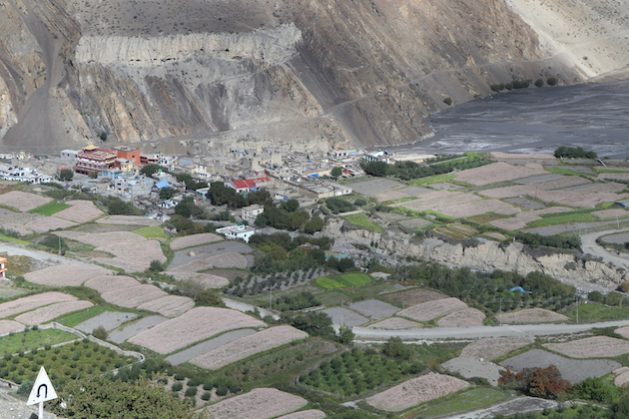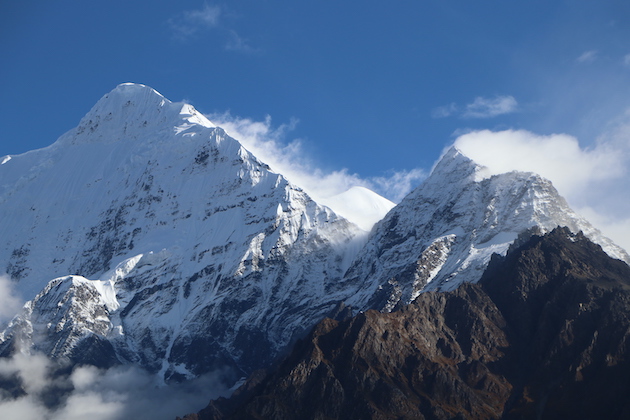Why Floods Beyond Our Imagination Hit Nepalese Himalayan Town

KATHMANDU, Sep 26 (IPS) - After heavy rains caused a flash flooding in the high mountains in the trans-Himalayan Mustang district of Nepal, residents and scientists have called for additional research and risk reduction measures in a region now considered vulnerable to climate-change-related disasters.
When a flash flood descended on a Himalayan community in the Mustang district in Nepal, it shocked the residents, climate change experts, and disaster risk management.
Anil Pokharel described it as "beyond our imagination." He has experienced many disasters as the Chief Executive at the National Disaster Risk Reduction and Management Authority for the Government of Nepal.
"The extreme events in Mustang this year surprised us because it was unusual and beyond our imagination," says Pokharel. "Now we are trying to comprehend what actually happened and what we can do to avoid such events in the future, but we are certain that the risk of unexpected disasters is increasing."
On August 13, 2023, Kagbeni village in Varagung Muktichhetra Rural Municipality-4, Mustang, experienced a flash flood where mud and water caused approximately USD 7.4 million worth of destruction.

The torrential rainfall in the mountain district, which is popular with tourists, some 450km west of Kathmandu, caused the Tiri River, which snakes through the area, to burst its banks, resulting in an unprecedented flash flood in the Kagkhola River. As a result, 50 houses were damaged, a motorable bridge and three temporary bridges were destroyed, and more than 31 indigenous and endangered Lulu cows died. It also caused damage to other livestock and agriculture. Lives were spared because the community was warned to move to safety before the mud and sludge hit the town.
Mustang, known for its majestic mountain terrain and beautiful Himalayan range, was surprised to experience the wrath of this extreme event.
"We were not ready for this type of incident," said Hom Bahadur Thapa Magar, the Chief Administrative Officer of Varagung Muktichhetra Rural Municipality.
"In fact, that flash flood exceeded our worst possible imagination."
What Caused the Flood?
Diki Gurung, a resident and vice-chair of the Municipality, stated that she had never seen a flood like this in her lifetime.
"We don't know what caused it, but it was not like this before."
Gurung's family has lived in the region for generations.
"My mother didn't go through this type of incident, and I remember my grandmother saying that in her time, there were floods, but not like this one."
She believes villages in mountain regions are experiencing changes in rainfall patterns, and the intensity of the rain has increased, putting them at risk of new types of disasters such as floods and debris flows. These have been increasing each year.
"Maybe it is because of the changing climate," Gurung speculates.
In June 2021, another mountain region, Manang, experienced unusually intense rainfall and destructive flooding. In the same year, the upper area of Shindhupalchwok also went through heavy rainfall-caused flood-related disasters. In recent years, mountain areas have witnessed changes in precipitation patterns, with unusually intense weather events becoming more frequent, and there is data to prove it.
On August 13, the Department of Hydrology and Meteorology (DHM) 's weather station at Jomsom Airport, Mustang, recorded 25.4 mm of rainfall in one day, unusual for that area where the average August rainfall is 43.9 mm. Mustang received above-normal rain in just three days, from 12 to August 14. On August 12, the area received 9.2 mm, 25.4mm on August 13, and 18 mm on August 14. According to the data from Jomsom Weather Station, August recorded 217.3 mm of rainfall, which is 495 percent more than the average rainfall for the area. In recent years, mountain districts like Mustang and Manang have received more rain than usual, and this year is following the trend.
Scientists say climate change-induced extreme weather events cause the heightened risk of floods and disasters in Himalayan villages like Kagbeni.
"It feels like heavy rainfall over a short period and flash-flood-like disasters are becoming a trend in the mountain regions," says scientist Dr Arun Bhakta Shrestha. "It's not only in Mustang this year; there were similar cases in Manang and the upper hills of Shindhupalchwok in 2021. The root of these disasters is connected to the upper streams, and changed precipitation patterns are one of the main causes."
Shrestha, who leads the Strategic Group for Reducing Climate and Environmental Risk at the International Centre for Integrated Mountain Development (ICIMOD), a regional intergovernmental learning and knowledge center for countries in the Hindu Kush Himalaya region, including Nepal, conducted research after the Melamchi flood in June 2021.
The study concluded that multiple factors contributed to that significant disaster, including intense rainfall in high mountain areas. While no such research exists on the Mustang flood, there are similarities with past events in Manang and Shindhupalchwok.
Recent IPCC reports also suggest extreme weather events and their intensity increase due to human-induced climate change.
"Climate change-induced changes in weather patterns could be one of many reasons for the Mustang flood, but we need to conduct research to understand it better," Shrestha noted. He signaled that climate change could be one of several causes.
Demand for Special Risk Reduction and Disaster Plans
High mountain areas and the communities living there were already at risk due to the growing threat of glacial lake outburst floods (GLOFs) caused by rising temperatures and their diverse and rapid impacts on the region.
Shrestha added: "In our observations, precipitation is becoming more frequent in high mountain regions, increasing the possibility of disasters other than GLOFs, too."
That's why, after the Mustang flood this year, there is a growing demand for specialized disaster risk reduction and management plans from local governments to experts in the field.
"A place like Mustang is not only known for its beautiful mountain ranges but also its vulnerability to disasters," said Chief District Officer (CDO) Anup KC. "This region requires tailored and geography-aware development and disaster risk management plans."
According to CDO KC, the recent flood is a wake-up call for disaster management officials at the provincial and federal levels, highlighting the increased vulnerability to disasters in Himalayan regions like Mustang.
Scientists like Shrestha agree.
"We are aware that our overall disaster preparedness is not strong, and this is even weaker in mountain regions due to their challenging geography and incomplete understanding of the risks," he says. "Flash floods in high mountains are entirely new to us, and we need to understand and prepare for them with the specific needs of these areas in mind. We must adopt a multi-hazard risk management and preparedness approach."
What Will Be the Next Step for Preparedness?
Officials at the National Disaster Risk Reduction and Management Authority (NDRRMA) are aware of the growing demand for a comprehensive and specialized plan for the mountain region that addresses the unique needs of the Himalayas. Two geo-engineers from NDRRMA visited the flood-affected area to observe and better understand the event.
"However, we recognize that we cannot do this on our own," added NDRRMA's Chief Executive, Anil Pokhrel. "We are open to collaborating on research and need additional resources to address the increasing risks in the Himalayas."
According to him, complex hazard systems are becoming more apparent in the mountains, leading to cascading impacts.
"That's why we need global cooperation and collaboration to understand these complex hazards, which will help us create suitable plans that do justice to the Himalayas and its communities."
IPS UN Bureau Report
Follow @IPSNewsUNBureau
Follow IPS News UN Bureau on Instagram
© Inter Press Service (2023) — All Rights Reserved. Original source: Inter Press Service
Where next?
Browse related news topics:
Read the latest news stories:
- Energy Transfers Lawsuit Against Greenpeace Is an Attempt to Drain Our Resources and Silence Dissent Friday, April 04, 2025
- Global Disability Summit Galvanizes Education Support for Crisis-Impacted Children with Disabilities Thursday, April 03, 2025
- World Autism Awareness Day 2025: Sustainable Development Must Include Neurodivergent Perspectives Thursday, April 03, 2025
- Solar-Powered Spinning Machines Help Indian Women Save Time and Earn More Thursday, April 03, 2025
- DR Congo: Millions Facing Destitution as Violence Forces People to Flee Multiple Times Thursday, April 03, 2025
- ‘Every piece tells a story’: Bombs to beauty, from Gaza to Ukraine Thursday, April 03, 2025
- DR Congo: Armed violence displaces thousands as cholera outbreak worsens Thursday, April 03, 2025
- World News in Brief: Israeli military escalation in Syria, Nicaragua rights probe, South Sudan talks Thursday, April 03, 2025
- Gaza: UN rights chief calls for probe into killings of medical workers Thursday, April 03, 2025
- UN envoy urges international support for West Africa and the Sahel Thursday, April 03, 2025
Learn more about the related issues: